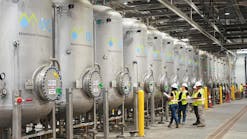LANCASTER, PA, March 14, 2014 -- According to a recent Environmental Protection Agency (EPA) report, a cost-effective solution to controlling stormwater while providing numerous economic benefits can be green infrastructure. The EPA used the city of Lancaster, Pa., as a case study and sought to quantify the economic benefits associated with utilizing green infrastructure for controlling wet-weather pollution.
The report estimated that within the combined sewer system (CSS) area, Lancaster's green infrastructure plan will reduce gray infrastructure capital costs by $121.7 million and reduce wastewater pumping and treatment costs by $661,000 annually. It will also provide approximately $2.8 million in energy, air quality and climate-related benefits per year. These benefits exceed the costs of implementing green infrastructure, which were estimated to range from $51.6 million if these projects were integrated into already-planned improvements, to $94.5 million if they were implemented independently.
"The city has invested more than $25 million over the past decade in gray infrastructure improvements to increase the capacity of the city's wastewater system," said Lancaster Mayor Richard Gray. In spite of this investment, a significant amount of untreated combined sewage continues to overflow into the Conestoga River and eventually into the Chesapeake Bay. Green infrastructure will help reducethe volume of stormwater entering our wastewater system and, at the same time, transform the city into a more sustainable, healthy community."
Unlike single-purpose gray stormwater infrastructure, which uses pipes to dispose of rainwater, green infrastructure uses vegetation and soil to manage rainwater where it falls. By weaving natural processes into the built environment, green infrastructure provides not only stormwater management, but also flood mitigation, air quality management and community revitalization. In 2011, Lancaster released its green infrastructure plan developed with help of city, county and state agencies. It identified opportunities for adding green infrastructure throughout the city within 5-year and 25-year timeframes, estimated the water quality benefits, and articulated a series of policy, outreach and technical recommendations for implementing green infrastructure in the city.
Because of the plan and the city's interest in understanding the added benefits of green infrastructure, EPA selected the city of Lancaster to serve as a case study for calculating the additional environmental, social and economic benefits. "Valuing multiple benefits of green infrastructure ensures water management investments by the city will help beautify, provide a safer, healthier and more prosperous community," said Liz Deardorff, Clean Water Supply director at American Rivers. "The results of this study affirm that green infrastructure has multiple benefits for both large and small cities needing to reduce pollution and ensure clean water."
Lancaster, like hundreds of other cities across the country, has both a CSS and a municipal separate storm sewer system (MS4). While the CSS collects both sewage and stormwater and conveys flows to a wastewater treatment plant, the MS4 collects only stormwater runoff and discharges flow directly to receiving streams. Further, the report summarized how installing green infrastructure in the CSS area could reduce gray infrastructure capital investments and associated wastewater pumping and treatment costs, as well as how installing green infrastructure in both the CSS and MS4 areas could produce a range of environmental benefits across the city.
###


